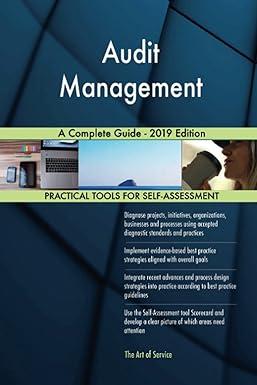Question
Drewniak Corporation has provided the following data from its activity-based costing system: Activities Estimated Overhead Cost Expected Activity Assembly $978,200 67,000 machine-hours Processing orders $94,905
Drewniak Corporation has provided the following data from its activity-based costing system: Activities Estimated Overhead Cost Expected Activity Assembly $978,200 67,000 machine-hours Processing orders $94,905 1,900 orders Inspection $134,292 1,860 inspection-hours The company makes 440 units of product O37W a year, requiring a total of 700 machine-hours, 41 orders, and 11 inspection-hours per year. The product's direct materials cost is $36.17 per unit and its direct labor cost is $29.91 per unit. According to the activity-based costing system, the unit product cost of product O37W is closest to: $95.77 per unit $86.80 per unit $66.08 per unit $94.15 per unit
Addy Company has two products: A and B. The annual production and sales of Product A is 2,650 units and of Product B is 2,050 units. The company has traditionally used direct labor-hours as the basis for applying all manufacturing overhead to products. Product A requires 0.4 direct labor-hours per unit and Product B requires 0.7 direct labor-hours per unit. The total estimated overhead for next period is $109,300. The company is considering switching to an activity-based costing system for the purpose of computing unit product costs for external reports. The new activity-based costing system would have three overhead activity cost pools--Activity 1, Activity 2, and General Factory--with estimated overhead costs and expected activity as follows: Total Estimated Overhead Costs Expected Activity Product A Product B Total Activity 1 $33,774 1,950 1,550 3,500 Activity 2 19,237 2,650 1,150 3,800 General Factory 56,289 1,060 1,435 2,495 Total $109,300 (Note: The General Factory activity cost pool's costs are allocated on the basis of direct labor-hours.) The overhead cost per unit of Product B under the traditional costing system is closest to: $30.67 $16.91 $13.76 $15.15
Aujla Corporation uses activity-based costing to determine product costs for external financial reports. The company has provided the following data concerning its activity-based costing system: Activities (and Activity Measures) Estimated Overhead Cost Machine related (machine-hours) $343,040 Batch setup (setups) $391,980 General factory (direct labour-hours) $282,720 Expected Activity Activities Product X Product Y Total Machine related 5,700 7,700 13,400 Batch setup 11,400 2,700 14,100 General factory 4,700 7,700 12,400 Assuming that actual activity turns out to be the same as expected activity, the total amount of overhead cost allocated to Product X would be closest to: $391,980 $844,280 $452,300 $570,000
Accola Company uses activity-based costing. The company has two products: A and B. The annual production and sales of Product A is 1,900 units and of Product B is 1,100 units. There are three activity cost pools, with estimated costs and expected activity as follows: Activities Estimated Overhead Cost Expected Activity Product A Product B Total Activity 1 $51,597 1,400 1,300 2,700 Activity 2 $73,115 2,400 1,100 3,500 Activity 3 $87,450 760 740 1,500 The overhead cost per unit of Product A is closest to: $63.79 $70.72 $82.69 $47.88
Cabigas Company manufactures two products, Product C and Product D. The company estimated it would incur $164,520 in manufacturing overhead costs during the current period. Overhead currently is applied to the products on the basis of direct labor-hours. Data concerning the current period's operations appear below: Product C Product D Estimated volume 2,000 units 2,700 units Direct labor-hours per unit 1.50 hours .60 hour Direct materials cost per unit $ 20.75 $ 28.60 Direct labor cost per unit $ 22.00 $ 9.20 Requried: a-1. Compute the predetermined overhead rate under the current method. (Round your answer to 2 decimal places.) Predetermined overhead rate $ per DLH a-2. Determine the unit product cost of each product for the current year. (Do not round your intermediate calculations. Round your final answer to 2 decimal places.) Product C Product D Unit product cost $ $
Addy Company has two products: A and B. The annual production and sales of Product A is 2,600 units and of Product B is 2,000 units. The company has traditionally used direct labor-hours as the basis for applying all manufacturing overhead to products. Product A requires 0.3 direct labor-hours per unit and Product B requires 0.6 direct labor-hours per unit. The total estimated overhead for next period is $108,775. The company is considering switching to an activity-based costing system for the purpose of computing unit product costs for external reports. The new activity-based costing system would have three overhead activity cost pools--Activity 1, Activity 2, and General Factory--with estimated overhead costs and expected activity as follows: Activities Estimated Overhead Costs Expected Activity Product A Product B Total Activity 1 $33,611 1,900 1,500 3,400 Activity 2 19,144 2,600 1,100 3,700 General Factory 56,020 1,500 1,740 3,240 Total $108,775 (Note: The General Factory activity cost pool's costs are allocated on the basis of direct labor-hours.) The predetermined overhead rate (i.e., activity rate) for Activity 2 under the activity-based costing system is closest to: $5.17 $29.40 $34.58 $7.36
The controller of Ferrence Company estimates the amount of materials handling overhead cost that should be allocated to the company's two products using the data that are given below: Wall Mirrors Specialty Windows Total expected units produced 7,600 2,500 Total expected material moves 760 960 Direct labor-hours per unit 6 6 The total materials handling cost for the year is expected to be $18,305.10. If the materials handling cost is allocated on the basis of direct labor-hours, how much of the total materials handling cost should be allocated to the wall mirrors? (Round your intermediate calculation to four decimal places. Round your final answer to nearest whole dollar.) $45,600 $13,776 $9,244 $9,153
Step by Step Solution
There are 3 Steps involved in it
Step: 1

Get Instant Access to Expert-Tailored Solutions
See step-by-step solutions with expert insights and AI powered tools for academic success
Step: 2

Step: 3

Ace Your Homework with AI
Get the answers you need in no time with our AI-driven, step-by-step assistance
Get Started


